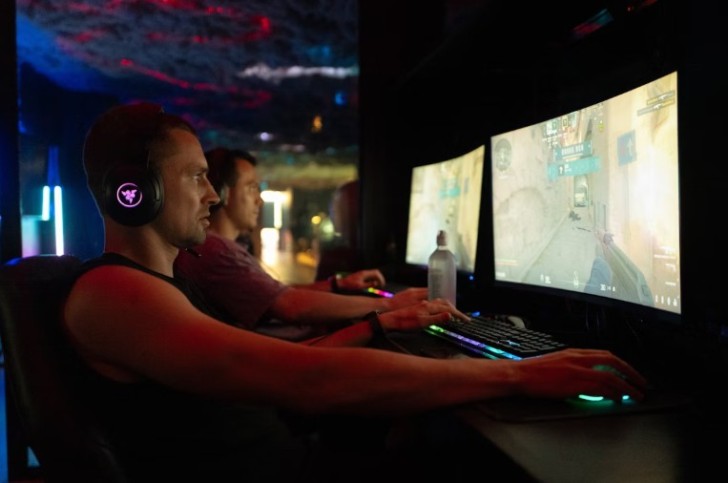Let's dive into the games dominating screens worldwide and explore what makes the current multiplayer ecosystem so compelling – along with the challenges facing serious players looking to gain every possible advantage.
Top Multiplayer Games Dominating in 2026
The current multiplayer hierarchy shows both established giants maintaining their dominance and fresh challengers disrupting the status quo. On PC, several titles have solidified their positions at the top:
Fortnite continues its cultural reign with nearly 31 million monthly active users, constantly reinventing itself through seasonal changes and collaborations that keep its battle royale format surprisingly fresh six years after launch.
Roblox straddles both PC and mobile platforms masterfully, boasting a staggering 130 million monthly mobile players alone. Its user-created experiences continue evolving from simple diversions into sophisticated competitive arenas.
Minecraft maintains its creative sandbox appeal while expanding its multiplayer survival modes, proving that building and cooperation can be just as engaging as pure combat.
League of Legends holds steady as the MOBA standard-bearer, with its intricate team dynamics and near-endless strategic depth keeping players locked in its ecosystem despite numerous challengers.
Meanwhile, shooters like Counter Strike 2, Valorant, Apex Legends, and the latest Call of Duty: Modern Warfare edition continue battling for the tactical FPS crown, each carving out dedicated communities around their unique mechanics and competitive scenes.
Mobile's Competitive Revolution
The mobile scene has witnessed explosive growth in truly competitive titles that demand the same skill and dedication as their PC counterparts:
Honkai: Star Rail has established itself as more than just a gacha game, with its PvP elements creating surprising depth for mobile players seeking strategic challenges.
Brawl Stars continues refining its accessible-yet-deep formula, with short matches perfectly suited to mobile play sessions while still rewarding mechanical skill.
Pokémon GO has evolved far beyond its casual collecting roots, with competitive leagues and high-stakes events drawing millions of daily players.
Fresh entries like Punch TV and Destiny Rising have disrupted the mobile scene with sophisticated progression systems and competitive formats previously reserved for PC titles. These games demonstrate how the platform gap continues narrowing, with mobile hardware now capable of delivering experiences that rival traditional gaming platforms.
The Evolution of Competitive Play
What's particularly interesting about 2025's multiplayer landscape is how competitive structures have evolved across all platforms. We're seeing several key trends reshaping how players approach these games:
Team-based coordination has become paramount, with even traditionally solo experiences like battle royales emphasizing squad play and communication. Games are increasingly designed around complementary abilities and synergies rather than individual heroics.
Skill-based matchmaking has grown more sophisticated, creating more balanced experiences but also more challenging environments where players can no longer rely on encountering significantly less skilled opponents.
In-game ranked leagues have become standard features, giving players clear progression paths and stakes beyond simple win-loss records. These structured competitive formats create compelling reasons to improve rather than just play casually.
Persistent Challenges for Competitive Players
Despite advances in technology and game design, several pain points continue frustrating competitive players:
Input lag and network instability remain the invisible enemies of competitive gaming. Even milliseconds of delay can determine outcomes in high-level play, especially as games increasingly support cross-platform competition between players on different devices and connections.
Hardware disparities create tangible advantages for players with access to better equipment. High-refresh monitors, responsive peripherals, and powerful processing can translate directly into competitive edges, creating an unfortunate correlation between spending power and performance potential.
Meta shifts and balance updates force constant adaptation. While necessary for game health, these changes can invalidate thousands of hours of practice overnight, requiring players to perpetually relearn optimal strategies.
Cheating and unethical enhancements unfortunately remain prevalent issues across competitive gaming. The arms race between developers and those creating unauthorized tools continues escalating, creating frustration for players seeking fair competition.
Community Resources for Competitive Edge
In response to these challenges, player communities have developed sophisticated support systems. Platforms like Battlelog serve as comprehensive hubs where competitive players share knowledge about optimal strategies, hardware recommendations, and tools to maximize performance across today's most demanding titles.
These community-driven resources have become essential for players seeking to stay current with rapidly evolving metas and technical requirements. They aggregate insights from professional players, tournament broadcasts, and hardware benchmarks into practical advice that helps bridge the gap between casual and competitive play.
The Future of Competitive Gaming
Looking forward, the multiplayer landscape appears focused on several emerging trends:
The line between competitive and cooperative experiences continues blurring, with games like Monster Hunter Wilds, Elden Ring: Nightreign, and Dune: Awakening emphasizing challenging PvE content that requires team coordination comparable to traditional esports.
Cross-platform play has become the expected standard rather than a novel feature, creating truly unified player bases regardless of preferred gaming device. This accessibility has dramatically expanded competitive scenes that were previously fragmented across different platforms.
The distinction between casual and professional play continues narrowing, with even recreational players adopting training regimens, specialized equipment, and analytical approaches previously reserved for professionals.
As multiplayer gaming continues evolving through 2026 and beyond, the competitive landscape promises to grow even more sophisticated, demanding, and rewarding for those willing to invest in improving their skills and understanding the complex ecosystems surrounding today's most popular titles.
 Editorial staff
Editorial staff

 Editorial staff
Editorial staff

